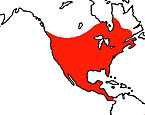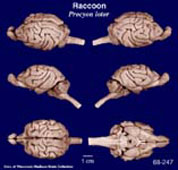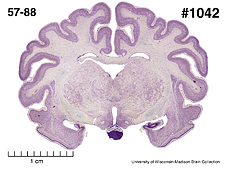|
Raccoon
(Procyon lotor) #57-88 |
||||
|
|
Physical
characteristics and distribution
|
|
Adult weights vary with habitat but an average is about 5.5 to 9.5 kg (12 to 21 pounds). They have black facial colorings around the eyes, and have a bushy tail with light and dark alternating rings. The coat is a mixture of gray, brown, and black fur. On rare occasions, raccoons may be albino. The characteristic eye colorings make the animal look like it is wearing a "bandit's mask. Two subgenera and seven species are currently recognized. Raccoons frequent timbered and brushy areas, usually near water. They are more nocturnal than diurnal and are good climbers and swimmers. The den is usually in a hollow tree, or in a rock crevice, an overturned stump, a burrow made by another animal or a human building. Each den is usually occupied for only one or two days. Raccoons do not hibernate. In southern parts of their range they are active year around. Raccoons are outstanding in their active use of their sensitive forepaws in grasping, feeling and palpating objects and surfaces. When is available, they will dip objects in water. We believe that the sensitivity of the glabrous forepaws is increased thereby and allows the animal to detect greater sensory detail. Studies of the relatively large sensory hand area of the cerebral cortex support this notion of the functional significance of moistening the hands and objects. The omnivorous diet consists mainly of crayfish, crabs, other arthropods, frogs, fish, nuts, seeds, acorns and berries. Home ranges of adult males do not overlap, but they do with the ranges of females. In the United States, the reproductive season extends from December to August. Mating occurs in February and March, and births from April to June. Gestation period averages 63 days. Litter size is one to seven. Eyes open after 3 weeks, weaning takes place from 7 weeks to 4 months. Raccoons
are common throughout S Canada, Mexico, USA (except
parts of the Rocky Mtns) to Panama.
|
|
Description
of the brain
|
|
Animal
source and preparation
|
|
All
specimens collected followed the same preparation
and histological procedure.
|
Other
Related Resources (websites and publications)
List of Specimens | Explore Collections | Brain Sections | Brain Evolution | Brain Development | Brain Circuitry | Brain Functions | Location and Use | Related Web Sites | Contact Us | Search MSU Database | Personnel | Home



